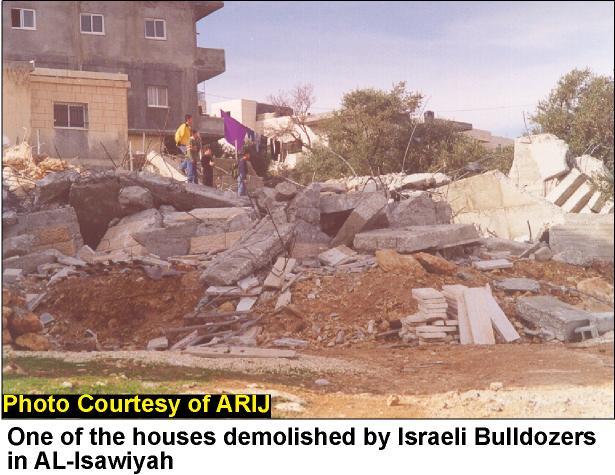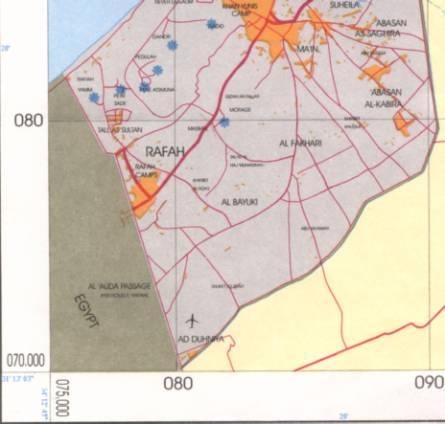The residents of Al-Isawiyah woke up on the morning of 14/1/2002 at the noisy sound of huge bulldozers and more than 500 security men surrounding the village from all its entrances. They started demolishing 9 houses composed of 13 apartments belonging to 13 families. The total number of people affected was 78; more than half of them were children. See Photo 1 & Photo 2 .
Al-Isawiyah is a victimized town by occupation:
Al-Isawiyah town is located northeast of Jerusalem. Its area during the British mandate was 12,000 dunums (1200 ha) and was populated by 1,800 people. Although many of its inhabitants immigrated as a result of wars, political and economic harsh circumstances, it is currently populated by 9,000 people. However, their remaining land is estimated at 666 dunums that is composing the master plan of the town. The area designated for construction does not exceed 350 dunums; therefore, the population density of this Arab quarter is 3 persons per m2. In addition to that, the construction system is very old and is not updated to suit modern standards that avoid property fragmentation and to be able to absorb the population growth. For example, the vertical expansion in construction is not allowed and land settlement and registration is halted due to Israeli Occupation. Also, the lack of interest from Jerusalem Municipality to find solutions for housing problem in this crowded quarter that resembles the refugee camps is evident.
Israeli Occupation violations against Al-Isawiyah:
After the Israeli occupation in 1967 and the annexation of Jerusalem to Israeli sovereignty, Al-Isawiyah became one of 28 villages and hamlets of metropolitan Jerusalem that got transformed to full Israeli sovereignty. Since then the chain of discriminatory policies against the Arabs started and are represented in the following:
1. The confiscation of 800 Dunums from the land of Al-Isawiyah for the interest of Hebrew University and Hadassah Hospital bordering the town from the west and the south.
2. Establishing a military camp on an overlaying hill southeast of Al-Isawiyah; See Photo 3.
- The confiscation of 600 Dunums for the benefit of Giva't Shapira settlement at the western part of the town.
- The confiscation of 800 Dunums at the eastern and northern part of the town and considering it as a state land. Their owners are prevented from its utilization either in building or agriculture.
- The closure and consideration of 200 Dunums as a green land which means, as usually known, that building on this land is forbidden. The ex-mayor of Jerusalem, Teddy Kollek, considered this land as a strategic reserve for Jewish colonial activities.
- Construction of a bypass colonial road passing from the northern and eastern part of the town at the expense of Al-Isawiyah land. This road surrounded and suppressed the building land and imposes a buffer zone of 75 m width to the downtown direction.
- In 1990, Al-Isawiyah Development Committee submitted an appeal to Jerusalem Municipality asking for the extension of the town master plan. Mrs. Sarah Kaminikar , an ex municipality council member at Jerusalem Municipality and urbanist, helped them in this appeal. However, Jerusalem Municipality rejected completely this appeal in 1995.
- Since 1985, 34 cases of demolishing inhabited houses have been documented, in addition to three houses that were under construction. Also, six inhabited barracks were demolished in addition to 23 tents populated by residents of Al-Isawiyah, See Photo 4.
The indications for the Israeli policy of racism and discrimination at Al-Isawiyah are obviously seen. Of the evidences are the following:
- Limiting Al-Isawiyah master plan to the horizontal layout of built-up area that existed in 1967.
- Bypassing the Israeli law itself by preventing the Palestinians living in Jerusalem from utilizing their legal right to object the demolition of their houses at the proper time. For example, the employees of Jerusalem Municipality submitted the demolition orders at 22:30 o'clock at night on Saturday dated 12/1/2002, stating an ultimatum of 24 hours. They put the orders on a cold night and late hour. Therefore, most of the house owners were not informed about these orders until the bulldozers and excavators started the demolition.
- Closing the town and preventing the peaceful protesters from reaching the site.
- Arresting, hitting and detaining most of the house owners present at the site in a brutal way preventing them from expressing their anger and protest.
Prepared by
The Land Research Center
LRC

















